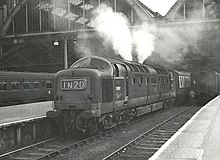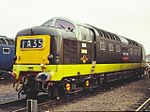British Rail Class 55
Twenty-two locomotives were built, designed for the high-speed express passenger services on the East Coast Main Line (ECML) between Edinburgh and London King's Cross.[3][4] The other notable features of the locomotive were its large size by British standards and striking styling, which was inspired by the bulldog nosed American diesels of the era.[3][4] At the same time, the management of the British Railways Eastern Region were looking for a replacement for their pre-war fleet of Class A4 steam locomotives for use on top-link expresses on the East Coast Main Line.Gerry Fiennes, the traffic manager of the ECML, believed that his expresses should be able to achieve an end-to-end average speed of 70–75 miles per hour (113–121 km/h) in order to remain competitive with other forms of transport, he felt that they could not wait more than a decade for service improvements by electrification when the expanding road network was taking away passengers, and opted instead for high speed-diesel traction as an interim solution.However, as the Deltic prototype had the necessary power and speed to achieve Gerry Fiennes's desired performance improvements, he persuaded British Railways to purchase a fleet of locomotives based on it.[3][4] On one of O. S. Nock's first Deltic runs (the down Heart of Midlothian loaded to 13 coaches, 530 tons gross) he stated "once the tail of the train was over the 60 mph restriction the throttle was opened to the full, and the surge forward could be felt in the cab.The down (northbound) working of this service achieved an average speed of 91.4 mph (147.1 km/h) from King's Cross to its first stop at Retford, making it the fastest regular locomotive-hauled train in Britain at the time.In the early 1970s they were fitted with Electric Train Heating (ETH) equipment to power Mark 2 air-conditioned coaches, while a couple of years later, with the introduction of BR's TOPS computer system, they were renumbered 55 001 to 55 022.[3][4] In the late 1970s, the Deltics began to take on secondary roles, gradually being supplanted by the next generation of express passenger services, namely the "InterCity 125" High Speed Train (HST) which were introduced on the ECML from 1978.Various alternative uses for the fleet were examined, but this came to nothing: A significant weakness of the Deltics were their high running costs, due to the complexity of their engine design which required expensive specialist maintenance, which mitigated against their redeployment elsewhere.The Friends of the National Railway Museum sponsored the repaint of 55 002 into original green livery for its last eighteen months in traffic, although it carried its TOPS number rather than D9002.[4] As insurance, in case 55 002 should meet with a mishap during its last months, the withdrawn 55 005 The Prince of Wales's Own Regiment of Yorkshire was set aside from breaking up at Doncaster Works until Deltic operation on the main line had concluded.[14] The last train was an enthusiast special, the "Deltic Scotsman Farewell", on 2 January 1982, hauled from King's Cross to Edinburgh by 55 015 Tulyar and 55 022 Royal Scots Grey on the return.The next opportunity to see a Deltic back on the mainline and running under its own power was in April 1985 when D9000 was sent (at the request of ScotRail management) light engine from Haymarket depot to Perth for an open day.In fact, the characteristics of the Deltic locomotives, powerful and capable of cruising at 100 mph (160 km/h), enabled them to fit more easily onto the modern rail network than other, slower, preserved diesels.On 23 September 2006, 55 022 (D9000) Royal Scots Grey returned to the main line after a lengthy and extensive restoration at Barrow Hill, carried out on behalf of the owners by the DPS.By January 2007, the faulty power unit was removed from 55 022, put into storage and replaced by an ex-marine Napier Deltic engine modified for rail use; work was completed by Royal Scots Grey's restoration team in August 2007.After extensive testing at the East Lancs Railway the locomotive hauled its first tour since the previous engine malfunction on RTC's 'Autumn Highlander' with 50 049 and 40 145 in October 2007.55 022 successfully hauled a number of charter tour services during 2008 but the replacement marine-sourced engine gave rise for concern following the discovery of oil in the coolant and at the end of August the locomotive was removed from future large railtour duties.In mid January 2007, an agreement was reached between heritage railway Peak Rail and the owner of D9016 Gordon Highlander which entailed the move of the locomotive from Barrow Hill to the preserved line for a period of three years.However, the sale of the locomotive to the Harry Needle Railroad Company and subsequent announcements indicated that the weekend runs of 27 and 28 September 2008[28] might be its last prior to component recovery and eventual scrapping.The route taken, partially to prevent false fire alarms in underground tunnels caused by the Deltic engine's emissions, takes the train as far as Craigendoran on the north bank of the Clyde before turning round toward Kilmarnock.On 29 November 2017 it was announced via the official Royal Scots Grey website that 55 022 and D9016, plus all spares, had been sold by Martin Walker to Locomotive Services Limited,[33] with both making the trip to LSL's Crewe Diesel TMD base in December 2017.[43][44] In February 2023 Hornby announced a new diecast Dublo tooling in OO gauge of the Deltic prototype locomotive, English Electric DP1 'Deltic', fitted with sound (R30297TXS).





















English ElectricVulcan FoundryCo′Co′standard gaugelong tonsshort tonsPrime moverNapier DelticGeneratorTraction motorsDiesel electricMU workingElectric Train HeatingTrain brakesVacuumTractive effortBritish RailwaysRoute availabilitydiesel locomotiveEast Coast Main LineEdinburghLondon King's CrossDP1 DelticStoke Bank"InterCity 125" High Speed TrainsHull ExecutiveBritish Rail DP1Dick, Kerr & CoPrestonopposed pistonweightbulldog nosedBritish Railways Eastern RegionClass A4electrifyGerry FiennesEnglish Electric Type 4Nigel GresleyPacificsservice contractBritish RailDoncaster WorksNewton-le-WillowsFinsbury ParkGatesheadNewcastleHaymarketBritish ArmyLondon and North Eastern RailwayracehorsesClass 23CoronationFlying ScotsmanO. S. NockPeterboroughThirskDarlingtonInterCity 125sRetfordSelby DiversionInterCityRail Blueair brakevacuum brakingMark 2"InterCity 125" High Speed TrainExeterBournemouthNational Railway MuseumAberdeenConington, Huntingdonshirepermissive block workingConnington South rail crashmanslaughterRail accidents at MorpethAberdonianMorpethNorthumberlandClass 101Tees Valley lineBarrow HillRoyal Scots GreyCrewe Diesel TMDThe King's Own Yorkshire Light InfantryThe Green HowardsBarrow Hill RoundhouseAlycidonTulyarGordon HighlanderMargateRoyal Highland FusilierArgyll & Sutherland HighlanderDeltic 9000 FundNene Valley RailwayNetwork SouthEastSelhurstOld Oak CommonSt. Rollox railway worksGlasgowHarrogateAnglia RailwaysVirgin CrossCountryLocomotive Services LimitedShildonBarrow Hill Engine ShedDeltic Preservation SocietyNorth York Moors RailwayBritish Rail Class 67Great Central Railway (heritage railway)Brush TractionLoughboroughPorterbrookPeak RailHarry Needle Railroad CompanyDirect Rail ServicesEast Lancashire RailwayGreat Central RailwayWashwood HeathBritish Rail DP2Great Western Main LineReadingLinlithgowBritish Rail Engineering LimitedScotRailHaymarket depotChris Green